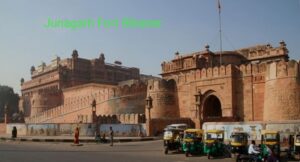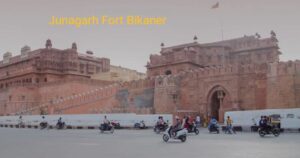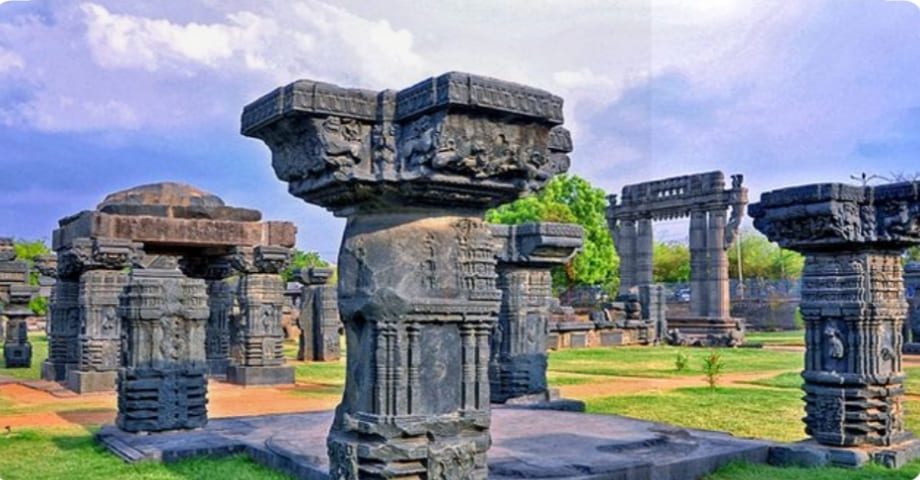Junagarh Fort Bikaner,stands as a majestic symbol of Bikaner’s rich history and architectural brilliance. Unlike many forts in Rajasthan, Junagarh is unique because it was never built on a hilltop but rather on the plains, reflecting a blend of security and splendor. Its impressive architecture and historical significance make it one of the most important landmarks in Bikaner, drawing tourists from across the globe. This blog explores the historical background, architectural marvels, and cultural significance of Junagarh Fort, making it a must-visit destination in Rajasthan.

1. Junagarh Fort Bikaner: Historical Background
Junagarh Fort’s history dates back to the late 16th century. It was constructed under the supervision of Raja Rai Singh, the sixth ruler of Bikaner, who reigned from 1571 to 1611. Rai Singh was a general in the army of Emperor Akbar, and his close association with the Mughal empire provided him with the resources and architectural insights necessary to build such a grand fort.
The construction of the fort began in 1589 and was completed in 1594. Originally called “Chintamani,” it was later renamed Junagarh, meaning “Old Fort,” after the ruling family moved to Lalgarh Palace in the early 20th century. Despite facing numerous attacks and sieges, Junagarh Fort remains unconquered, a testament to its strategic planning and the valor of Bikaner’s rulers.
2.Junagarh Fort Bikaner: Architectural Style
Junagarh Fort is an architectural masterpiece, showcasing a blend of Rajput, Mughal, and Gujarati styles. The fort is a sprawling complex with a mix of red sandstone and marble structures, each reflecting the artistic and cultural influences of its time. The fort’s intricate carvings, delicate latticework, and ornate balconies are a testament to the craftsmanship of the artisans who built it.
The fort’s layout includes several palaces, temples, and pavilions, each with unique architectural features. The interiors are adorned with exquisite mirror work, frescoes, and gold leaf paintings, adding to the fort’s grandeur. The fort’s impressive battlements and defensive structures highlight the strategic importance it held in the past.
3.Major Attractions within Junagarh Fort
Junagarh Fort is home to several palaces and structures that are of great historical and architectural significance. Here are some of the key attractions:
– Karan Mahal: Originally built as a public audience hall, Karan Mahal was later converted into a hall of private audience. It is one of the oldest parts of the fort and showcases beautiful carvings and ornate windows, reflecting a mix of Mughal and Rajput styles.
– Phool Mahal: Also known as the “Palace of Flowers,” Phool Mahal was the private chamber of the Maharajas. The palace is famous for its stunning floral motifs and mirror work, making it one of the most beautiful structures within the fort.
– Anup Mahal: This multi-storied palace served as the administrative headquarters of the Bikaner state. Anup Mahal is known for its intricate woodwork, elaborate ceilings, and red and gold décor, symbolizing the power and prestige of the rulers.
– Chandra Mahal:Perhaps the most luxurious part of the fort, Chandra Mahal is adorned with gold-plated deities, delicate mirror work, and elaborate paintings. The palace reflects the opulence of the royal lifestyle.
– Ganga Mahal: Built in the early 20th century, Ganga Mahal houses a museum that displays a vast collection of artifacts, including weapons, manuscripts, and royal costumes. The museum offers a glimpse into the rich history and culture of Bikaner.
– Badal Mahal: Unique for its paintings of clouds, Badal Mahal stands out as a symbol of creativity and imagination. The walls depict scenes of monsoon clouds, providing a cool and serene ambiance.

4.Significant Historical Events
Junagarh Fort has witnessed several significant historical events. Throughout its history, the fort faced numerous attacks, but it was never conquered. One of the most notable events was the siege by the Mughal Emperor Aurangzeb in the late 17th century. Despite being heavily outnumbered, the fort’s defenders managed to hold off the invaders, showcasing their bravery and strategic acumen.
The fort also played a crucial role in the power struggles between the Rajput kingdoms and the Mughal empire. It served as a military base and a symbol of resistance against foreign invasions. The stories of valor and heroism associated with Junagarh Fort continue to inspire generations.
5.Cultural Significance
Junagarh Fort is not just an architectural marvel; it is also a cultural hub that has played a significant role in shaping the identity of Bikaner. The fort has been a center of art, culture, and religious activities for centuries. Various festivals and events, such as Diwali, Dussehra, and Gangaur, are celebrated within the fort premises, adding to its cultural significance.
The fort’s temples, including the Har Mandir, where the royal family worshipped, highlight the spiritual aspect of the fort’s cultural life. The fort has also influenced the local crafts and traditions, with many artisans drawing inspiration from its intricate designs and motifs.
6.Restoration and Preservation
Over the centuries, Junagarh Fort has undergone several restoration and preservation efforts to maintain its architectural integrity and historical significance. The fort’s preservation is a challenging task due to its age and the wear and tear it has endured.
The Archaeological Survey of India (ASI) and other heritage organizations have undertaken various projects to restore and preserve the fort’s structures. These efforts include repairing damaged sections, restoring frescoes and paintings, and maintaining the fort’s overall structure. The local government and the royal family of Bikaner have also played a crucial role in preserving this historical treasure.
7.Visitor Information
For those planning to visit Junagarh Fort, the best time to explore this architectural marvel is during the winter months, from October to March, when the weather is pleasant. The fort is open to visitors every day from 10:00 AM to 4:30 PM. The entry fee is nominal, and guided tours are available for those interested in learning more about the fort’s history and architecture.
Nearby attractions include the Lalgarh Palace, the National Research Centre on Camel, and the Gajner Palace. Visitors can also explore the local markets of Bikaner, famous for their handicrafts, sweets, and snacks.
Conclusion:
Junagarh Fort is more than just a historical monument; it is a symbol of Bikaner’s rich heritage and cultural legacy. The fort’s architectural splendor, coupled with its historical significance, makes it a must-visit destination for history enthusiasts and tourists alike. A visit to Junagarh Fort offers a deep dive into the royal past of Bikaner, providing a unique experience that blends history, culture, and art. Exploring the fort is like stepping back in time, where every stone and every carving tells a story of valor, grandeur, and tradition.
FAQ:
1.Why is Bikaner fort called Junagarh fort?
2.What is the story of Junagarh fort?
3.How much time does it take to visit Junagarh fort?
4.Which fort of Junagadh is very old?
5.Junagarh fort bikaner distance
6.Junagarh fort bikaner ticket price
7.Junagarh fort bikaner timings
8.Junagarh fort bikaner wikipedia
9.Junagarh Fort Bikaner History in Hindi
10.Junagarh Fort Bikaner Contact number
11.Junagarh fort bikaner entry fee
12.Junagarh fort bikaner history
13.10 lines on Junagarh Fort in English

